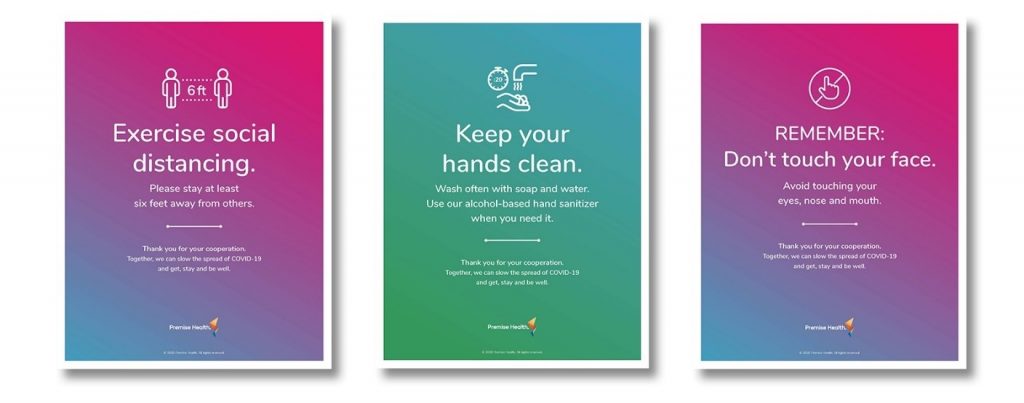Ways HR Professionals Can Support Campus Reopening
When it comes to employees returning to the workplace, there isn’t a one size fits all approach. Every business is unique, with teams working in different sized spaces from high rise office buildings to large manufacturing plants. One thing is certain: approaches to re-open campuses will look different for everyone but having a clear plan in place will make all the difference.
Throughout this process, HR professionals play an essential role in bringing workers back to campus through a combination of strategies that help keep team members safe, informed, and healthy.

Read on to see what you can do as an HR professional to support a successful campus reopening.
Promote Relevant Benefits and Resources
Your people are your greatest asset and it’s important that they’re aware of the resources newly available to them, or those they’ve had access to but may have forgotten about. When people understand their benefit options, they are better equipped to overcome challenges when life happens.
Start by taking an assessment of what new offerings your organization is providing to employees in response to COVID-19. For example, some employers are giving their workforce advanced paid time off, help with childcare expenses, and making it an option to defer 401k payments. Additionally, to keep employees active, some organizations are even giving their teams access to virtual fitness programs. These unique offerings can help employees who are feeling the burden of coronavirus find some relief in their daily lives.
Next, think about the mental health of your population – what resources are readily available that team members may not know about? For instance, employee assistance programs (EAP) are often underutilized and are a great tool for managing acute stressors and immediate short-term needs. By making your employees aware that they have access to an EAP resource, they can begin working through personal issues that may have been triggered while at home. Promoting access to relevant behavioral health resources can help employees cope with stress and anxiety. Your company might consider these tips as well.

Here are three ways to promote your available resources:
- Beef up your newsletter communications to include important details about new and existing benefit and wellbeing offerings.
- Send postcards to your population with information about EAP benefits and how to access them.
- For those on campus or returning soon, post plenty of signage that encourages employees to maintain good hygiene, physical distancing, and to wear face coverings to mitigate transmission risk.
Communicate Often
Adapting to a new normal will take time and patience, and some employees at your organization may seem resistant or hesitant to these changes. At some point, if you haven’t already, you will have a worker that is denied entry into the building due to a positive or suspected COVID-19 case. So what happens next and how can you help navigate their quarantine experience? Ensure there’s a process in place for those who become infected, make sure to keep lines of communication open, and be prepared for COVID-19 related questions.
For instance, an employee who tested positive for COVID-19 might be wondering if there’s required paperwork they need to fill out, how long they have to wait to come back to work after they’ve recovered, or what to do if they run out of sick days. They also might have privacy concerns, need additional support through isolation, or want information about what your organization is doing to protect the safety of those at the workplace. There are many strategic tactics you can put in place today to get ahead of these types of inquiries.
Some key communication tactics to consider for your campus re-opening strategy:
- Develop process and communication materials for those individuals who are denied entry and consider how they are referred to appropriate onsite or community providers for additional screening and care navigation.
- Make sure new tactics around communications, processes and protocols are prominently displayed and easily found on the home page of your company’s intranet site.
- Communicate mass screening and testing details such as location and screening/testing expectations at least a week in advance prior to members returning to the workplace. This will reduce confusion and excessive delays when mass screenings are conducted on campus.
- Expand communication programs to ensure employees understand timely healthcare topics like herd immunity and have access to relevant workplace safety resources.
As an HR professional, it is critical that you have the proper channels in place to facilitate two-way communication as employees return to campus. This means embracing transparency and leveraging employee feedback to adapt policies, protocols, and communications that facilitate a successful return-to-work strategy and helps you retain top talent.
Whether that’s addressing concerns directly through e-mail or in a weekly newsletter, your people need to know their voice is heard and can trust they have someone on their side as they get adjusted to their new working environment. Being armed with actionable information and ready to adapt as needed will help build confidence in the eyes of employees and secure your role as a trusted resource.
Help Members Navigate Care
Receiving an unexpected healthcare diagnosis is often met with a range of emotions, with fear of how to navigate it and anxiety over the outcome. For those who have a confirmed positive or suspected coronavirus diagnosis, these emotions can be amplified due to the degree of uncertainty around effects to the body and need to isolate from social interaction. A COVID-19 diagnosis can produce a new level of stress as individuals try to navigate their care plan in isolation.
Care navigation is an approach to supporting members by helping them navigate their healthcare journeys to ensure they get the care they need. A care navigator may be the one person a member speaks to in a day due to limited social interaction, which can have a positive impact not only on someone’s physical health, but also on their mental and emotional health.
Continuing to engage with your population ensures they are receiving the right care at the right time to get them back to living their healthiest lives. For those who have put off routine care, make sure they know about their options and where to go as restrictions are lifted. Helping your people stay on top of their preventive care needs leads to better long-term health.
Approaches to support employee health in the months to come:
- Make it easy for team members to prioritize their health and wellbeing through convenient access to virtual or in-person care.
- Ensure that sick leave policies are flexible and consistent with public health guidance and that employees are aware of these policies.
- Recommend that employees who do not feel well contact their healthcare provider team virtually to assess their condition and receive appropriate clinical guidance and ongoing support.
- Ensure non-punitive measures are in place to support employees who request essential leave.
- Consider changing existing HR policies or plan design to appropriately incentivize members to access healthcare services that might have been deferred due to the pandemic.
- Invest in a care navigation solution for those with a confirmed or suspected coronavirus diagnosis.
As an HR professional, you play a very important role by helping your team members move confidently through the return to campus process. With the right information and resources readily available to your people, your organization will be in a better position to address the challenges that may come with returning to the workplace. Helping employees navigate the evolving pandemic so they can remain productive, healthy, and happy will foster a positive workplace culture for the long haul.
Premise Health is committed to protecting and promoting the health and safety of team members, members, and their families. As the COVID-19 outbreak evolves, our teams can play a critical role in reinforcing the country’s healthcare infrastructure. By delivering care at our health centers and pharmacies, we can alleviate the burden on community resources and provide continued access to high-quality healthcare.
From pandemic preparation and screening to response and return to work, we can help your organization strategically navigate this unprecedented and challenging time.
Contact us.
- If you are a Premise Health member with questions, call your health center.
- If you are a Premise Health client with questions, please contact your director of client operations.
- For media inquiries, please contact [email protected].
Premise Health is the leading direct healthcare provider offering onsite wellness centers, as well as nearsite and virtual access points. For the latest COVID-19 information from Premise Health, click here.
Next on industry insights.

[UPDATED] COVID-19: Screening and Testing Best Practices
Read the Blog
What Employers Need to Know About President Biden’s Path Out of the Pandemic COVID-19 Action Plan
Read the Blog